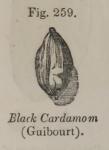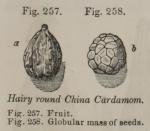Sa nhon, Cochinch.; So Xa mí. Chin, Loureiro.—Mountains of Cochinchina.
I am indebted to Professor Guibourt for specimens of a fruit which he calls the hairy China cardamom (cardamome poilu de la Chine), and which, in the collection of the Museum d'Histoire Naturelle, is termed (by mistake?) tsao keou.
Capsules ovate, oblong, obtusely triangular. Seeds have no linear depression or groove as those of the preceding variety, and by the absence of this they may be readily distinguished from it; coherent in masses, which are 3-lobed, not quite globular. In my specimens, the pericarp is rugous, as if eroded; but, when examined by a magnifier, it is seen to be covered by asperities and the remains of fine downy hairs. The flavour of the seeds is aromatic and terebinthinate, but not powerful.
M. Guibourt thinks this fruit may perhaps be the produce of Amomum villosum of Loureiro, the oriental names of which, however, are very different to that on the specimen in the Paris Museum. Loureiro states that the seeds of A. villosum are sub-calefacient and stomachic, and are exported from the provinces of Qúi-nhon and Phy-yeu, in Cochin China (where they grow spontaneously), to China, where they are largely used in medicine.
 Black Cardamom, Guibourt.—I am indebted to M. Guibourt for a fruit which be calls the black cardamom of Gaertner (cardamome noir de Gaertner), or the fruit of Zingiber nigrum, Gaertner. The capsule is larger than the short Malabar cardamoms, acuminate at its two extremities, and formed, as it were, of two obtusely-triangular pyramids joined base to base. The pericarp ash-brown, aromatic, but less so than the seeds. Seids annular, brown, slightly aromatic, but devoid of the terebinthinate flavour. Gaertner states that his plant is the Alughas of the Ceylonese. But the black cardamom of Guibourt is certainly not Roxburgh's Alpinia Allughas.
Black Cardamom, Guibourt.—I am indebted to M. Guibourt for a fruit which be calls the black cardamom of Gaertner (cardamome noir de Gaertner), or the fruit of Zingiber nigrum, Gaertner. The capsule is larger than the short Malabar cardamoms, acuminate at its two extremities, and formed, as it were, of two obtusely-triangular pyramids joined base to base. The pericarp ash-brown, aromatic, but less so than the seeds. Seids annular, brown, slightly aromatic, but devoid of the terebinthinate flavour. Gaertner states that his plant is the Alughas of the Ceylonese. But the black cardamom of Guibourt is certainly not Roxburgh's Alpinia Allughas.


